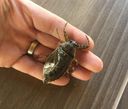Lethocerinae
Lethocerinae
Classification
- Phylum: Arthropoda
- Subphylum: Hexapoda
- Class: Insecta
- Order: Hemiptera
- Suborder: Heteroptera
- Infraorder: Nepomorpha
- Superfamily: Nepoidea
- Family: Belostomatidae
- Subfamily: Lethocerinae
Pronunciation
How to pronounce Lethocerinae: //ˌlɛθoʊsəˈraɪniː//
These audio files are automatically generated. While they are not always 100% accurate, they are a good starting point.
Images






Summary
Lethocerinae is a subfamily of large aquatic insects known as giant water bugs, characterized by their size, predatory behavior, and parental care during reproduction.
Physical Characteristics
Flattened, obovoid to ovoid-elongate body; forewings cover all of abdomen except for two tube-like appendages at posterior end; hind tarsi with two apical claws.
Identification Tips
Look for large size (up to 12 cm), flattened body, and the presence of forewings that cover the abdomen except for breathing tubes.
Habitat
Freshwater habitats including ponds, marshes, and slow-flowing streams.
Distribution
Worldwide, with more than 110 species in the Neotropics, over 20 species in Africa, and fewer elsewhere; most diverse in the New World.
Diet
Aggressive predators feeding on fish, amphibians, aquatic invertebrates, and occasionally baby turtles and water snakes.
Life Cycle
Males guard the eggs laid on emergent vegetation; eggs hatch and the young are cared for until they can fend for themselves.
Reproduction
In Lethocerinae, eggs are laid on emergent vegetation and guarded by males. Males care for the young post-hatching.
Predators
Large fish, birds, and some mammals may prey on juvenile and adult giant water bugs.
Ecosystem Role
Top predators in freshwater ecosystems, controlling populations of aquatic prey.
Economic Impact
Giant water bugs are harvested for food in some parts of Asia, particularly in Southeast Asia.
Cultural Significance
In Southeast Asia, certain species are considered a delicacy.
Health Concerns
Their sting can be excruciatingly painful, although it is not considered of medical significance.
Collecting Methods
- Using large floating traps in ponds
- Attracting adults with black lights at night
Preservation Methods
- Preserving in ethanol
- Drying specimens
Evolution
The Belostomatidae family dates back to the Late Triassic, with fossils indicating a long evolutionary history.
Similar Taxa
- Belostomatinae
- Horvathiniinae
Misconceptions
Often referred to as 'toe-biters', their sting is well-known but not medically harmful; they can play dead to evade predators.
Tags
- insects
- aquatic insects
- predators
- freshwater
- Lethocerinae
- Belostomatidae
- giant water bugs